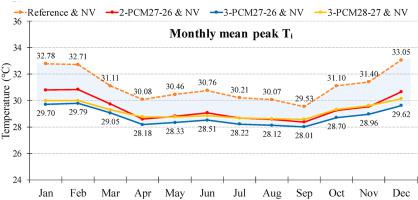Case Studies in Thermal Engineering ( IF 6.8 ) Pub Date : 2020-10-09 , DOI: 10.1016/j.csite.2020.100762 Zeyad Amin Al-Absi , Mohd Isa Mohd Hafizal , Mazran Ismail , Ahmad Mardiana , Azhar Ghazali

|
A hot-humid climate, which is characterized by uniform diurnal temperature throughout the year, can provide a year-round opportunity to benefit from phase change materials (PCMs) for buildings' application. However, the small diurnal temperature fluctuation might restrict the PCMs' performance and efficiency. This paper investigates the capability of PCMs to decrease the peak indoor air temperature (Tᵢ) of naturally conditioned buildings in a hot-humid climate region by storing night coolness. To this end, field measurement has been conducted in existing buildings to identify the appropriate transition temperatures' range for PCM. Then, a macro-encapsulated PCM with different transition temperatures and quantities has been numerically examined. The results showed a considerable reduction in peak Tᵢ, particularly when using PCMs with lower transition temperatures and higher quantities. Although uncompleted PCM freezing was observed when lower transition temperatures were used, it was tackled by combining night ventilation. Moreover, the PCMs showed effective year-round performance and achieved a reduction in the peak Tᵢ reached up to 4.87 °C. The optimal performance was achieved when using a combination of NV and PCMs with the lowest transition temperature that ensured complete PCMs freezing. Therefore, the PCMs’ freezing temperature should be considered when selecting PCMs for such conditions.
中文翻译:

使用相变材料在湿热气候下建筑物的峰值室内空气温度降低
一年四季均温的特点是炎热潮湿的气候,因此可以全年受益于相变材料(PCM)来进行建筑应用。但是,昼夜温差较小可能会限制PCM的性能和效率。本文研究了PCM通过存储夜间凉爽度来降低湿热气候地区自然空调建筑的峰值室内空气温度(Tᵢ)的能力。为此,已经在现有建筑物中进行了现场测量,以确定PCM的适当转变温度范围。然后,已经对具有不同转变温度和数量的宏封装的PCM进行了数值检查。结果表明,峰值Tᵢ大大降低,特别是在使用过渡温度较低且数量较大的PCM时。尽管在使用较低的转变温度时观察到PCM未完全冻结,但可以通过结合夜间通风来解决。而且,PCM显示出全年有效的性能,并降低了最高Tᵢ,最高达到4.87℃。当结合使用NV和PCM且具有最低的转变温度以确保PCM完全冻结时,可获得最佳性能。因此,在这种情况下选择PCM时应考虑PCM的冻结温度。PCM表现出全年有效的性能,并降低了最高Tᵢ,最高达到4.87°C。当结合使用NV和PCM且具有最低的转变温度以确保PCM完全冻结时,可获得最佳性能。因此,在这种情况下选择PCM时应考虑PCM的冻结温度。PCM表现出全年有效的性能,并降低了最高Tᵢ,最高达到4.87°C。当结合使用NV和PCM且具有最低的转变温度以确保PCM完全冻结时,可获得最佳性能。因此,在这种情况下选择PCM时应考虑PCM的冻结温度。



























 京公网安备 11010802027423号
京公网安备 11010802027423号